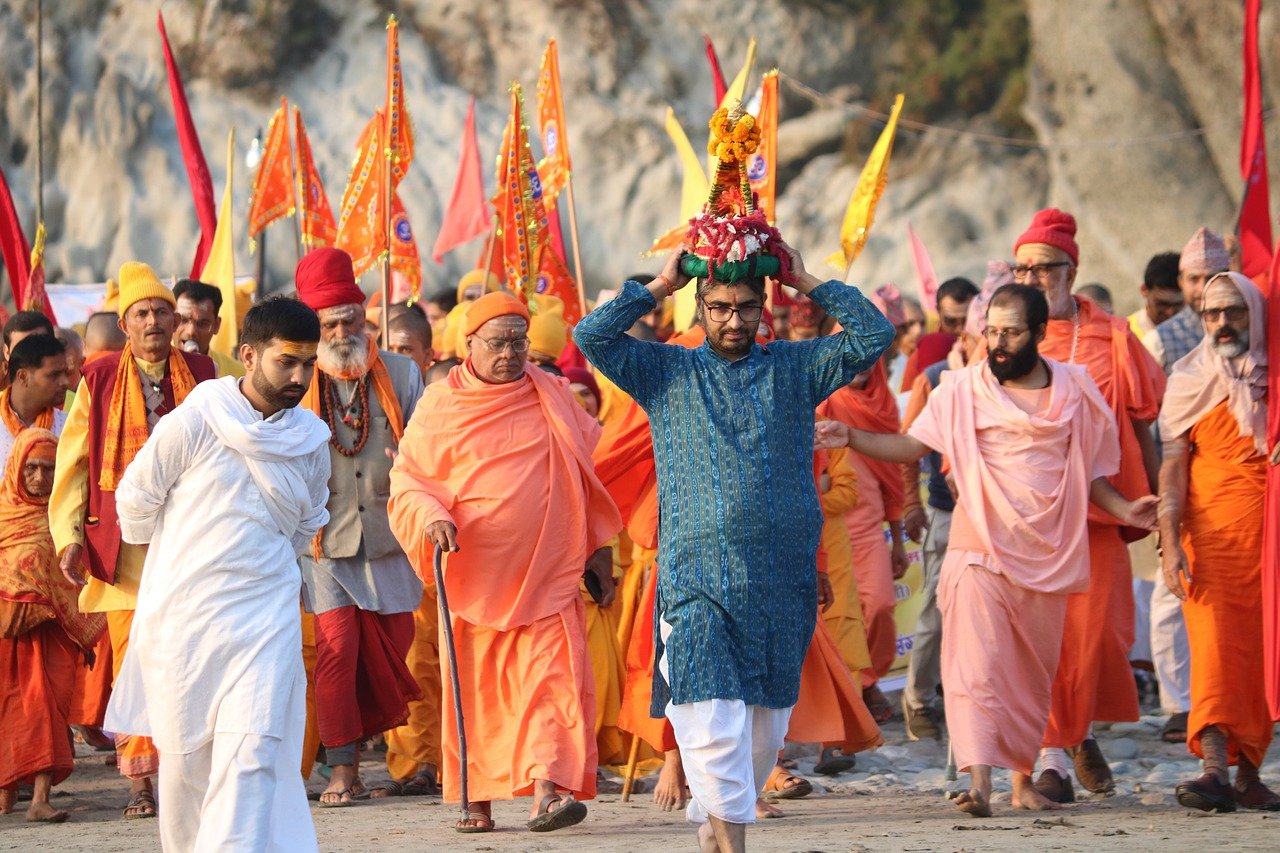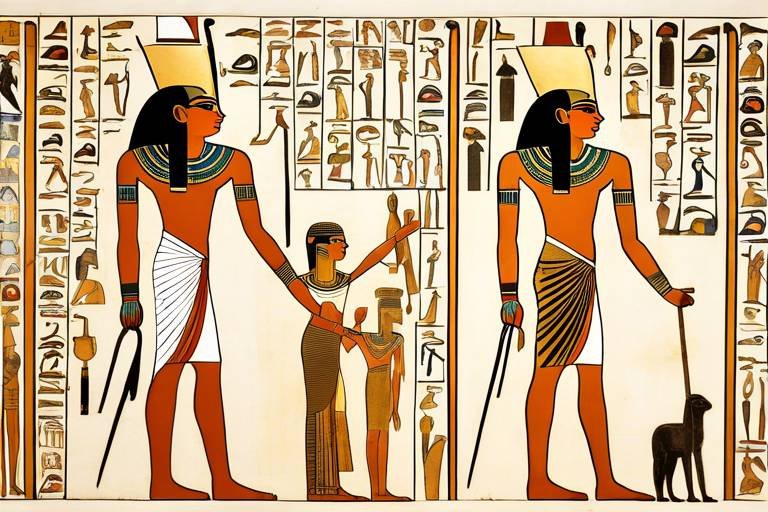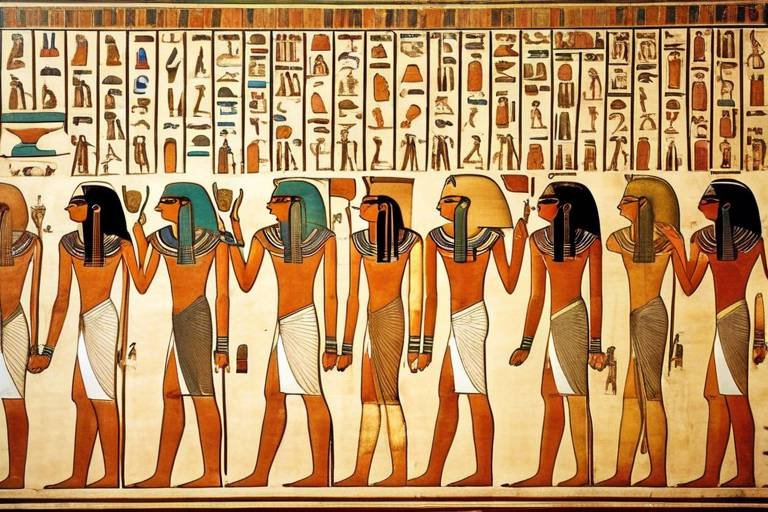The Secrets of the Sacred Texts of Ancient India
Have you ever wondered about the mystical and profound teachings hidden within the ancient texts of India? Journey with me as we unravel the enigmatic Vedas, the oldest scriptures of Hinduism, containing hymns, rituals, and philosophical teachings that lay the groundwork for Indian spirituality. These sacred texts are like portals to a bygone era, offering insights into the spiritual practices and beliefs of ancient sages.
Next, we delve into the mystical realm of the Upanishads, philosophical texts that explore the nature of reality, the self, and the ultimate truth. Imagine wandering through a labyrinth of profound wisdom, where each verse is a doorway to self-discovery and enlightenment. The Upanishads beckon us to question our existence and contemplate the mysteries of the universe.
Prepare to be captivated by the Bhagavad Gita, a timeless dialogue between Prince Arjuna and Lord Krishna on the battlefield of Kurukshetra. This sacred text offers guidance on duty, righteousness, and the eternal struggle between good and evil. Like a beacon of light in the darkness, the Bhagavad Gita illuminates the path of righteousness amidst the chaos of life.
As we journey further, we encounter the epic tale of the Ramayana, the story of Prince Rama's quest to rescue his beloved wife Sita from the clutches of the demon king Ravana. This ancient saga is a tapestry of loyalty, devotion, and the triumph of good over evil, weaving a narrative that resonates with the eternal battle between light and darkness.
Our exploration leads us to the Mahabharata, the longest epic poem in the world, narrating the Kurukshetra War and imparting moral and ethical lessons through its diverse characters and intricate plot. Within its pages, we find a reflection of human nature, with all its complexities and contradictions, laid bare for us to ponder.
Uncover the rich tapestry of myths, legends, and histories within the Puranas, ancient texts that offer insights into Hindu cosmology, genealogy, and religious practices. These sacred texts paint a vivid picture of the divine tapestry that weaves through the fabric of existence, connecting the past with the present in a timeless dance of creation.
Delve into the profound teachings of the Yoga Sutras of Patanjali, the foundational text of classical yoga philosophy. These sutras elucidate the path to spiritual liberation through the practice of meditation, self-discipline, and the cultivation of inner peace. Like a roadmap to the soul, the Yoga Sutras guide us on a journey of self-discovery and transformation.
Explore the Aranyakas, forest treatises that bridge the rituals of the Vedas with the philosophical inquiries of the Upanishads. These texts delve into the deeper meanings of sacrificial rites, meditation, and symbolism, inviting us to contemplate the interconnectedness of all things in the vast tapestry of existence.
Unravel the intricate web of Hindu law and ethics within the Smritis, texts that provide guidelines for personal conduct, social norms, and the administration of justice in ancient India. These sacred texts serve as a moral compass, guiding individuals and society towards harmony, justice, and righteousness.

Vedas
The Vedas are the oldest scriptures of Hinduism, dating back thousands of years. These sacred texts are a treasure trove of hymns, rituals, and philosophical teachings that serve as the cornerstone of Indian spirituality. Imagine them as the ancient blueprint that laid the foundation for the rich tapestry of beliefs and practices in Hindu culture. The Vedas offer a glimpse into the profound wisdom and spiritual insights of the ancient sages who composed these verses. It's like peering through a mystical window into the depths of human consciousness and the divine mysteries of the universe.

Upanishads
The Upanishads are a collection of mystical and philosophical texts that delve deep into the nature of reality, the self, and the ultimate truth. These ancient scriptures, composed in Sanskrit, form the concluding part of the Vedas and are considered the essence of Vedic knowledge and wisdom. Unlike the earlier Vedic hymns and rituals, the Upanishads focus on metaphysical questions and spiritual insights, aiming to unravel the mysteries of existence and consciousness.
Within the Upanishads, one encounters profound teachings on the nature of the self (Atman) and its relationship to the ultimate reality (Brahman). Through intricate dialogues and contemplative verses, the Upanishads explore the concept of unity between the individual soul and the universal consciousness, emphasizing the interconnectedness of all beings and the underlying oneness of existence.
One of the central themes of the Upanishads is the concept of 'jnana' or spiritual knowledge, which transcends mere intellectual understanding and leads to self-realization and liberation. These texts advocate introspection, meditation, and self-inquiry as the means to uncover the true nature of the self and attain spiritual enlightenment.
Moreover, the Upanishads challenge conventional notions of reality and perception, inviting readers to question the nature of the material world and delve into the realm of the unseen and eternal. By contemplating the profound insights offered in the Upanishads, one embarks on a transformative journey of self-discovery and spiritual awakening.

Bhagavad Gita
The is a revered scripture that holds a special place in Hindu philosophy and spiritual teachings. This ancient text, often referred to as the "Song of God," presents a profound dialogue between Prince Arjuna and Lord Krishna on the battlefield of Kurukshetra. As Arjuna grapples with moral dilemmas and existential questions, Lord Krishna imparts timeless wisdom and guidance on duty, righteousness, and the nature of reality.
Within the , readers are offered insights into the concepts of dharma (duty), karma (action), and yoga (union). The teachings of Lord Krishna emphasize the importance of fulfilling one's responsibilities without attachment to the outcomes, surrendering to the divine will, and striving for self-realization.
This sacred text delves into the essence of devotion, selflessness, and the eternal truths that govern human existence. It transcends the boundaries of time and space, offering a universal message of spiritual awakening and inner transformation.
Through the , readers are invited to contemplate the deeper meanings of life, the significance of ethical conduct, and the path to self-discovery. The dialogue between Arjuna and Krishna serves as a guiding light for those seeking clarity, purpose, and enlightenment in their journey through the complexities of existence.

Ramayana
Delve into the mystical world of ancient Indian scriptures, where wisdom and spirituality intertwine to form the foundation of a rich cultural heritage. From the oldest scriptures of Hinduism to the epic tales of gods and heroes, these sacred texts offer profound insights into the human experience and the cosmic order.
The is a timeless epic that narrates the heroic journey of Prince Rama as he embarks on a quest to rescue his beloved wife Sita from the clutches of the demon king Ravana. Filled with themes of loyalty, devotion, and the eternal battle between good and evil, the Ramayana is a story of love and sacrifice that continues to inspire generations.
At the heart of the Ramayana lies the unwavering bond between Rama and Sita, symbolizing the depth of true love and the enduring power of righteousness. As Rama faces numerous challenges and tests his courage and virtue, the epic unfolds a tapestry of moral lessons and ethical dilemmas that resonate with audiences across time and space.
Through the trials and tribulations of its characters, the Ramayana explores the complexities of human relationships, the consequences of choices, and the ultimate triumph of dharma over adharma. Each character, from the noble Rama to the cunning Ravana, represents facets of the human psyche and serves as a mirror for self-reflection and introspection.
The Ramayana is not merely a story but a spiritual journey that transcends the boundaries of time and space, inviting readers to ponder the deeper meanings of life and existence. Its enduring appeal lies in its universal themes of love, honor, and duty, which resonate with the core values of humanity and offer solace and guidance in the face of adversity.
As the epic unfolds through its vivid narratives and poetic verses, it weaves a tapestry of emotions and experiences that capture the essence of human nature and the eternal quest for truth and righteousness. The Ramayana stands as a testament to the power of storytelling and the enduring legacy of ancient wisdom that continues to illuminate the path of seekers and sages alike.
- What is the significance of the Ramayana in Hindu culture?
- Who is the author of the Ramayana?
- What lessons can be learned from the Ramayana?
The Ramayana holds immense cultural and religious significance in Hinduism as it embodies the ideals of righteousness, duty, and devotion. It serves as a moral compass for followers and a source of inspiration for spiritual seekers.
Valmiki is traditionally credited as the author of the Ramayana, having composed the epic in Sanskrit verse. His poetic rendition of Rama's journey has become a cornerstone of Indian literature and mythology.
The Ramayana imparts valuable lessons on loyalty, honor, sacrifice, and the eternal battle between good and evil. It teaches the importance of upholding dharma (righteousness) in the face of adversity and staying true to one's principles.

Mahabharata
The Mahabharata, an ancient Indian epic of immense proportions, stands as one of the most revered texts in Hindu mythology and literature. Spanning over 100,000 verses, this epic narrates the legendary Kurukshetra War between the Pandavas and the Kauravas, two branches of the Kuru dynasty. At its core, the Mahabharata delves deep into the complexities of human nature, moral dilemmas, and the eternal struggle between righteousness and evil.
Within the vast tapestry of the Mahabharata, readers encounter a multitude of characters, each with their own virtues, vices, and destinies. From the noble and virtuous Arjuna to the cunning and envious Duryodhana, the epic weaves together a rich tapestry of personalities that mirror the intricacies of human existence. Through their actions and choices, the Mahabharata imparts profound lessons on duty, honor, loyalty, and the consequences of one's decisions.
One of the most iconic sections of the Mahabharata is the Bhagavad Gita, a sacred dialogue between Prince Arjuna and Lord Krishna that takes place on the battlefield of Kurukshetra. In this philosophical discourse, Lord Krishna imparts timeless wisdom on dharma (duty), karma (action), and the path to spiritual enlightenment. The teachings of the Bhagavad Gita transcend time and space, offering guidance to seekers of truth and solace in times of moral ambiguity.
Moreover, the Mahabharata is not merely a tale of war and strife; it is a repository of moral and ethical teachings that resonate with readers across generations. Through the trials and tribulations faced by its characters, the epic imparts valuable lessons on the consequences of greed, jealousy, and ego, while also celebrating the triumph of righteousness and virtue.
As readers immerse themselves in the intricate plotlines and philosophical discourses of the Mahabharata, they are transported to a world where gods and mortals coexist, where honor is valued above all else, and where the consequences of one's actions reverberate through eternity. This epic saga continues to captivate hearts and minds, inviting readers to ponder the eternal questions of life, death, and the nature of existence.

Puranas
Exploring the ancient scriptures of India reveals a treasure trove of wisdom and knowledge that has shaped the spiritual and philosophical landscape of the country for millennia. From the mystical hymns of the Vedas to the profound teachings of the Upanishads, each sacred text offers a unique perspective on life, morality, and the universe. Let's delve into the secrets of these revered texts and uncover the timeless truths they hold.
The Puranas are a collection of ancient texts that serve as repositories of Hindu mythology, legends, and historical narratives. Comprising over 400, these texts provide valuable insights into the cosmology, genealogy, and religious practices of ancient India. Each Purana is dedicated to a specific deity or theme, weaving together stories of gods, sages, and heroes that offer moral lessons and spiritual guidance to believers.
One of the most famous Puranas is the Bhagavata Purana, which narrates the life and teachings of Lord Krishna, showcasing his divine play and miracles. Another prominent Purana is the Shiva Purana, which extols the glory of Lord Shiva and elucidates the significance of his various forms and manifestations.
These ancient texts not only entertain and inspire but also serve as a cultural touchstone for Hindus around the world, preserving the rich tapestry of myth and legend that forms the backdrop of their faith. Through the Puranas, believers can connect with the divine, learn moral values, and deepen their understanding of the intricate web of Hindu spirituality.
Furthermore, the Puranas play a crucial role in preserving the oral traditions of ancient India, ensuring that the stories of gods and goddesses, demons and sages, continue to be passed down through generations. By studying the Puranas, scholars and devotees alike can gain a deeper appreciation for the complexities of Hindu mythology and the enduring relevance of its teachings in contemporary society.

Yoga Sutras
The of Patanjali stand as a foundational text in the realm of classical yoga philosophy. These ancient aphorisms succinctly outline the path to spiritual liberation through the practice of meditation and self-discipline. Patanjali's Yoga Sutras consist of 196 sutras divided into four chapters, guiding practitioners on the journey towards self-realization and inner peace.
Within the , Patanjali delineates the eight limbs of yoga, known as Ashtanga Yoga, which serve as a roadmap for spiritual growth and enlightenment. These limbs include Yama (restraints), Niyama (observances), Asana (postures), Pranayama (breath control), Pratyahara (withdrawal of the senses), Dharana (concentration), Dhyana (meditation), and Samadhi (state of oneness).
One of the key themes explored in the is the concept of Chitta Vritti Nirodha, which translates to the cessation of the fluctuations of the mind. By quieting the mind and achieving a state of mental stillness, individuals can transcend the limitations of the ego and connect with their higher consciousness.
Patanjali emphasizes the importance of regular practice (Abhyasa) and non-attachment to results (Vairagya) as essential components of the yogic journey. Through disciplined effort and detachment from the fruits of one's actions, practitioners can cultivate a sense of inner detachment and equanimity in the face of life's challenges.
The offer profound insights into the nature of the mind, the obstacles to spiritual growth, and the practices that lead to self-realization. By delving into the teachings of Patanjali, individuals can embark on a transformative journey of self-discovery and inner transformation, ultimately experiencing the true essence of yoga as a path to liberation.

Aranyakas
Have you ever wondered about the mystical and profound teachings hidden within the ancient scriptures of India? Let's embark on a journey to unravel the secrets of the sacred texts that have shaped the spiritual and philosophical landscape of the Indian subcontinent for millennia.
Aranyakas, also known as the "forest treatises," serve as a bridge between the ritualistic practices outlined in the Vedas and the philosophical inquiries of the Upanishads. These texts delve into the deeper meanings of sacrificial rites, focusing on meditation, symbolism, and the connection between the individual soul and the universal spirit.
The Aranyakas are characterized by their contemplative nature, offering spiritual seekers a pathway to explore the mystical aspects of existence while residing in seclusion within the tranquil depths of the forest. These texts emphasize the importance of introspection, meditation, and the pursuit of higher knowledge beyond the material realm.
Within the Aranyakas, one can find symbolic interpretations of Vedic rituals, shedding light on the esoteric significance hidden within the outward practices. These texts invite individuals to contemplate the interconnectedness of all beings, the cyclical nature of existence, and the eternal quest for self-realization.
Through the Aranyakas, seekers are encouraged to transcend the boundaries of the physical world and embark on a spiritual journey towards enlightenment. These texts inspire introspection, meditation, and a deep connection with the divine essence that permeates all of creation.
1. What is the significance of the Aranyakas in Hindu philosophy?
The Aranyakas play a crucial role in bridging the gap between ritualistic practices and philosophical inquiries, offering seekers a deeper understanding of the spiritual dimensions of existence.
2. How do the Aranyakas differ from the Upanishads?
While the Upanishads focus on profound metaphysical teachings and the nature of reality, the Aranyakas provide a more practical and symbolic interpretation of Vedic rituals.
3. Are the Aranyakas accessible to modern readers?
Yes, many translations and interpretations of the Aranyakas are available today, allowing contemporary seekers to delve into the ancient wisdom contained within these mystical texts.

Smritis
The are a collection of Hindu texts that encompass various aspects of law and ethics. These texts serve as guides for personal conduct, societal norms, and the administration of justice in ancient India. They provide detailed instructions on moral behavior, duties of individuals based on their varna (caste), and guidelines for governance and social order.
One of the most well-known Smritis is the Manusmriti, attributed to the legendary sage Manu. This text outlines the duties and responsibilities of individuals belonging to different social classes, emphasizing the importance of righteousness, justice, and adherence to dharma (righteousness).
The Yajnavalkya Smriti is another significant text that focuses on laws related to marriage, inheritance, and societal conduct. It provides insights into the legal framework of ancient India and offers guidelines for resolving disputes and maintaining harmony within communities.
These Smritis play a crucial role in shaping the moral fabric of society and upholding the principles of dharma. They reflect the values and norms of ancient Indian civilization, highlighting the importance of ethical conduct, social responsibility, and adherence to traditional customs.
Frequently Asked Questions
- What are the Vedas?
The Vedas are the oldest scriptures of Hinduism, consisting of hymns, rituals, and philosophical teachings that serve as the foundation of Indian spirituality.
- What is the significance of the Bhagavad Gita?
The Bhagavad Gita is a profound dialogue between Prince Arjuna and Lord Krishna, offering timeless wisdom and guidance on duty, righteousness, and the nature of life itself.
- Why is the Ramayana considered an epic tale?
The Ramayana narrates Prince Rama's journey to rescue his wife Sita from the demon king Ravana, showcasing themes of loyalty, devotion, and the triumph of good over evil.
- What is the purpose of the Upanishads?
The Upanishads delve into mystical and philosophical concepts, exploring the nature of reality, the self, and the ultimate truth to help individuals on their spiritual path.
- How do the Yoga Sutras contribute to spiritual liberation?
The Yoga Sutras of Patanjali outline the path to spiritual liberation through meditation and self-discipline, providing a guide for individuals seeking inner peace and enlightenment.



















